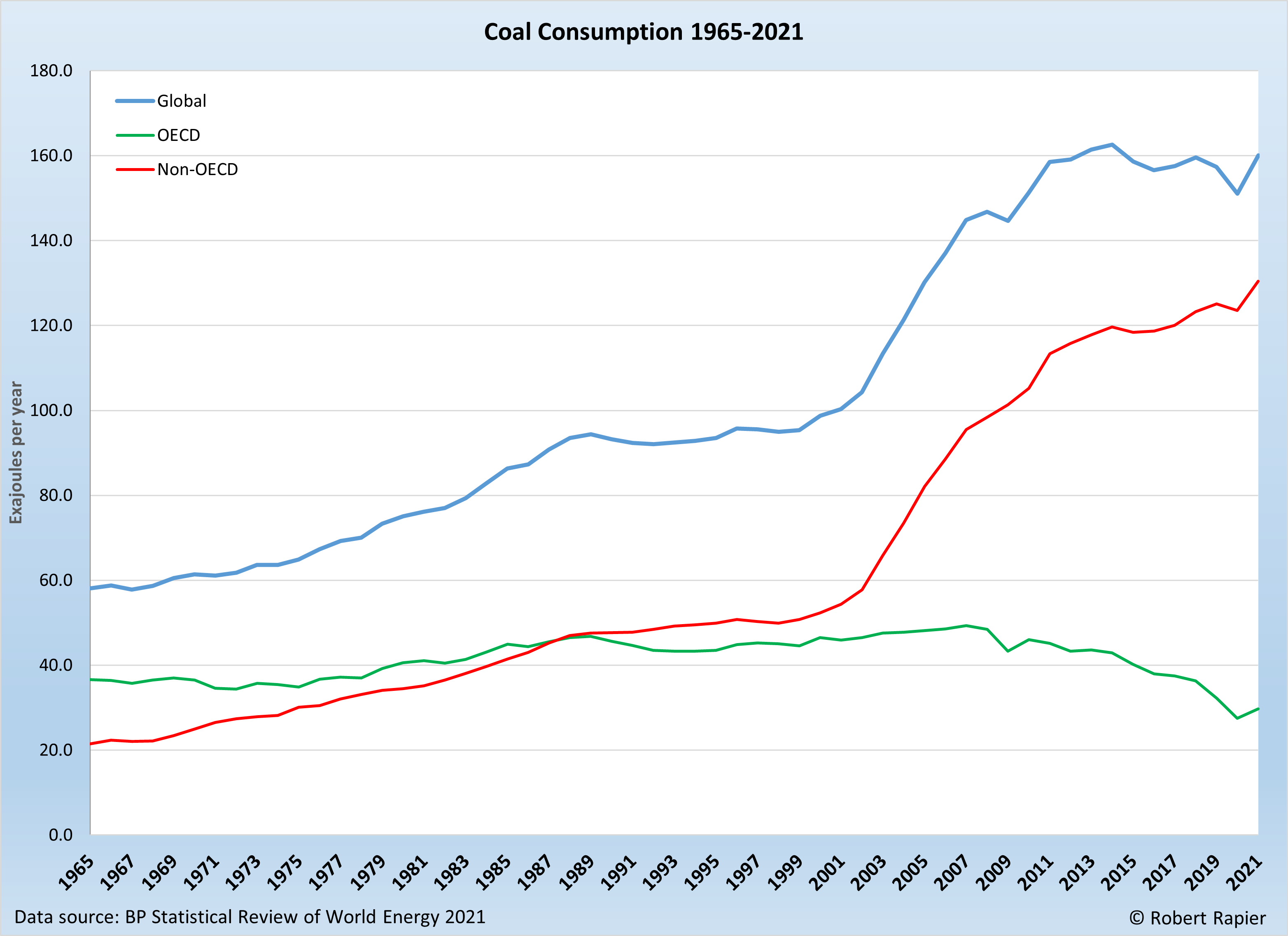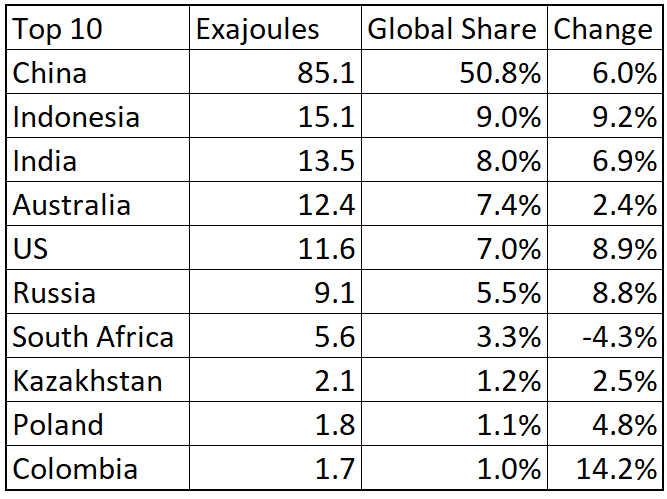
The Energy Collective Group
This group brings together the best thinkers on energy and climate. Join us for smart, insightful posts and conversations about where the energy industry is and where it is going.
Post
Global Coal Consumption Surged In 2021
This article is the fifth in a series on the BP Statistical Review of World Energy 2022. The Review provides a comprehensive picture of supply and demand for major energy sources on a country-level basis. Previous articles covered overall energy consumption, carbon dioxide emissions, petroleum supply and demand, and global natural gas trends.
Today I delve into the data on coal production and consumption.
Comparing Coal’s Emissions
Coal is the most polluting fossil fuel. What is meant by that?
Fossil fuels are primarily composed of carbon and hydrogen. They are hydrocarbons. When hydrocarbons are combusted, the carbon forms carbon dioxide and the hydrogen forms water vapor. Coal contains a higher percentage of carbon than does oil or natural gas. So, when coal is combusted, it generates more carbon dioxide per unit of energy than oil or natural gas will generate.
According to the Energy Information Administration (EIA), combustion of coal emits about 210 pounds of CO2 per million British thermal units (BTU) of energy. In comparison, oil emits about 160 pounds of CO2 per million BTU, and natural gas emits 117 pounds of CO2 per million BTU.
Coal also produces a lot of other harmful emissions when burned in power plants. Historically, coal plants emitted a lot of sulfur dioxide, which causes acid rain. Regulations eventually reined in that problem, but coal-fired power plants still emit pollutants like mercury. They even emit more radioactive elements into the environment than a nuclear power plant. Thus, there have been many regulations passed that have attempted to lower coal’s impact on the environment.
Because of the various pollution issues associated with coal, most developed countries have moved away from coal-fired power. But because coal is cheap, developing countries continue to rely heavily on coal as a source of power. Coal consumption in developing countries is presently the largest global driver of rising carbon dioxide emissions.
2021 Consumption and Production Statistics
As a result of the Covid-19 pandemic, 2020 saw a record 4.2% drop in global coal consumption. Within the 38 countries that comprise the Organisation for Economic Cooperation and Development (OECD), coal consumption fell in 2020 by 15.2%.
However, as with oil and natural gas, coal consumption bounced back strongly in 2021, growing by 6.3%. Coal consumption in non-OECD countries rose to a new record, while global coal consumption fell just short of the previous record set in 2014. Non-OECD countries now consume 81.5% of the world’s coal.

Six of the world’s ten largest consumers of coal are in the Asia Pacific region. All but one of last year’s Top 10 consumers saw an increase in coal consumption from 2020. Below were the world’s Top 10 coal consumers in 2021. “Change” refers to the growth or decline from the previous year.
Germany, which has been phasing out nuclear power and aggressively pursuing renewables, had the largest percentage increase in coal consumption from the previous year (among the Top 10 consumers).
Coal producers are geographically more diverse than coal consumers. Nevertheless, China dominates the world’s coal consumption and production. Below were the world’s Top 10 coal producers in 2021:
 The coal industry in the U.S. has seen both supply and demand steadily declining for 15 years. The dramatic decline in U.S. coal consumption is the primary reason U.S. CO2 emissions have fallen sharply in the past decade. Coal consumption in power plants was displaced by cheaper natural gas and renewables, both of which have a much lower carbon footprint. However, that downward trend reversed direction in 2021, which saw a surge in both coal production and consumption in the U.S.
The coal industry in the U.S. has seen both supply and demand steadily declining for 15 years. The dramatic decline in U.S. coal consumption is the primary reason U.S. CO2 emissions have fallen sharply in the past decade. Coal consumption in power plants was displaced by cheaper natural gas and renewables, both of which have a much lower carbon footprint. However, that downward trend reversed direction in 2021, which saw a surge in both coal production and consumption in the U.S.
In the next installment, I will take a closer look at global renewable energy trends.
Follow Robert Rapier on Twitter, LinkedIn, or Facebook.
Discussions
No discussions yet. Start a discussion below.
Get Published - Build a Following
The Energy Central Power Industry Network® is based on one core idea - power industry professionals helping each other and advancing the industry by sharing and learning from each other.
If you have an experience or insight to share or have learned something from a conference or seminar, your peers and colleagues on Energy Central want to hear about it. It's also easy to share a link to an article you've liked or an industry resource that you think would be helpful.






















Sign in to Participate